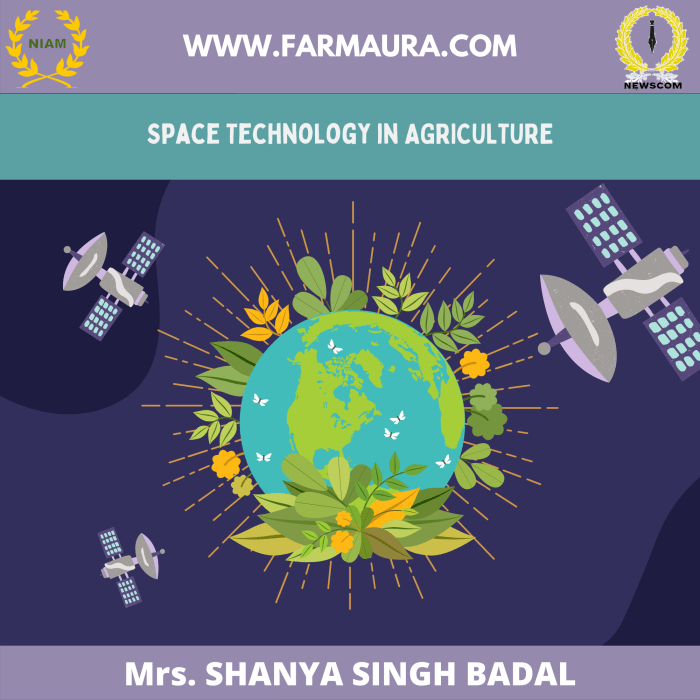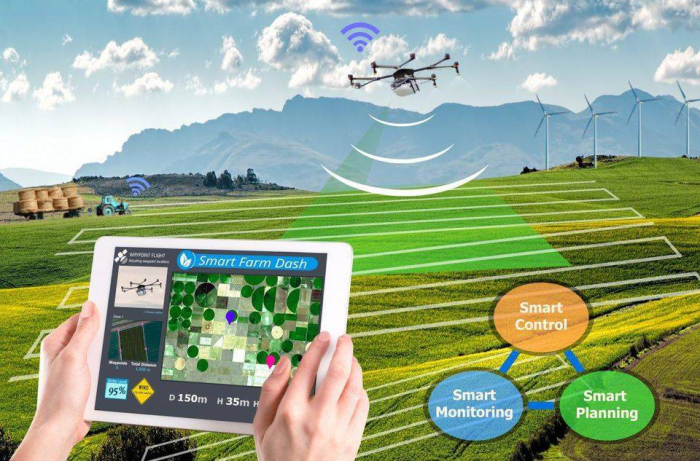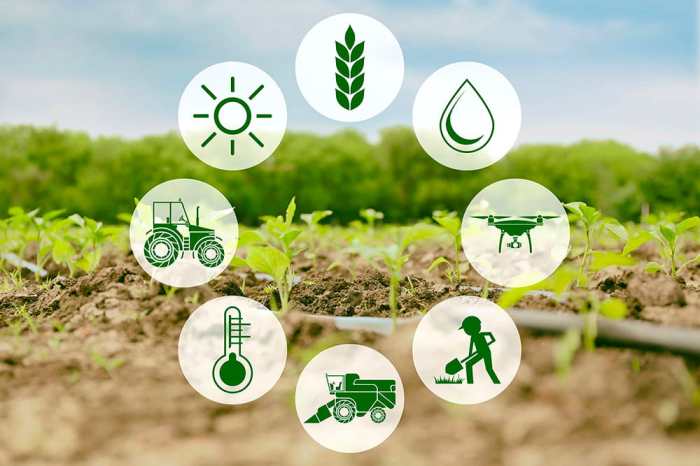This tech helps farmers protect their crops from space – Space Tech Helps Farmers Protect Crops takes center stage, bringing a futuristic twist to traditional farming practices. Imagine satellites peering down at vast fields, detecting early signs of disease or drought before they can wreak havoc on harvests. This isn’t science fiction; it’s the reality of precision agriculture, where space-based technology empowers farmers with unprecedented insights into their crops’ health and well-being.
From satellite imagery that reveals hidden patterns in plant growth to drones that deliver targeted treatments, these innovations are revolutionizing the way we feed a growing global population.
This tech helps farmers protect their crops from space by offering a bird’s-eye view of their fields, enabling them to make informed decisions about irrigation, fertilization, and pest control. This approach not only enhances yields but also minimizes environmental impact, promoting sustainable agriculture practices.
Space-Based Technologies for Crop Protection

Space-based technologies are revolutionizing agriculture by providing farmers with unprecedented insights into their crops and enabling them to make informed decisions for optimal yield and sustainability. These technologies offer a unique perspective from above, allowing for large-scale monitoring and analysis of fields that would be impossible or impractical to achieve from the ground.
Satellite Imagery for Crop Health Monitoring
Satellite imagery plays a crucial role in monitoring crop health by capturing data about various factors that influence plant growth. By analyzing multispectral images, farmers can gain valuable information about:
- Plant Vigor:Satellite sensors capture different wavelengths of light, allowing for the assessment of plant health based on their reflectance patterns. Healthy plants reflect more near-infrared light, indicating robust growth.
- Water Stress:Satellite data can reveal areas of drought stress by analyzing the moisture content of the soil. This information helps farmers optimize irrigation schedules and prevent crop damage.
- Nutrient Deficiencies:Satellite sensors can detect changes in plant chlorophyll levels, indicating potential nutrient deficiencies. This allows farmers to address specific nutrient needs for optimal growth.
Satellite imagery provides a comprehensive view of crop health across large areas, enabling early detection of problems and timely interventions.
Precision Agriculture and Space Technology

Precision agriculture is a data-driven approach to farming that uses technology to optimize resource use and improve crop yields. Space technology plays a crucial role in precision agriculture by providing valuable data that can be used to monitor crop health, identify areas of stress, and optimize resource allocation.
Space-Based Data for Precision Agriculture
Space-based data, primarily collected by satellites and drones, provides valuable insights into agricultural practices. This data can be used to monitor crop health, identify areas of stress, and optimize resource allocation. Remote sensing techniques allow farmers to gather information about their fields without physically visiting them.
Types of Sensors Used for Data Collection
Different types of sensors are used to collect data from space, each providing unique information about crops and the environment.
- Multispectral sensorscapture images in different wavelengths of light, allowing farmers to identify specific plant characteristics like chlorophyll content, water stress, and nitrogen levels. This data helps monitor crop health and detect potential problems early.
- Hyperspectral sensorscollect data in numerous narrow spectral bands, offering even more detailed information about plant physiology. This technology allows for precise identification of plant diseases, nutrient deficiencies, and stress levels.
- LiDAR (Light Detection and Ranging)sensors use laser pulses to create 3D models of the terrain, providing information about topography, elevation, and vegetation structure. This data helps in optimizing irrigation systems, managing soil erosion, and planning field operations.
- SAR (Synthetic Aperture Radar)sensors use radio waves to penetrate clouds and vegetation, providing data on soil moisture, crop growth, and even detecting potential pests and diseases. SAR is particularly useful in areas with frequent cloud cover or during nighttime.
Advantages and Limitations of Space Technology in Agriculture
Space technology offers numerous advantages for precision agriculture, but it also has some limitations.
Expand your understanding about spains crowmie empowers everyone invest green energy with the sources we offer.
| Advantages | Limitations |
|---|---|
| Provides comprehensive and timely data about large areas. | High initial investment costs for equipment and data analysis. |
| Enables early detection of crop stress, pests, and diseases. | Data interpretation and analysis require specialized skills. |
| Optimizes resource allocation, leading to increased yields and reduced costs. | Accuracy can be affected by factors like weather conditions and cloud cover. |
| Improves environmental sustainability by reducing chemical usage and water consumption. | Limited availability of high-resolution data in some regions. |
Applications of Space Technology in Precision Agriculture
Space technology has numerous applications in precision agriculture, contributing to improved efficiency, sustainability, and profitability.
- Crop monitoring and health assessment:Space-based data allows farmers to monitor crop growth, identify areas of stress, and detect potential diseases or pests. This information helps in timely intervention, reducing losses and optimizing crop yields.
- Precision irrigation:Data on soil moisture and evapotranspiration rates obtained from satellites and drones helps farmers optimize irrigation schedules, reducing water usage and improving water efficiency.
- Variable rate fertilization:Space-based data can identify areas of nutrient deficiency within fields, enabling farmers to apply fertilizer only where needed, reducing fertilizer costs and minimizing environmental impact.
- Yield prediction and forecasting:By analyzing data on crop growth, weather patterns, and soil conditions, farmers can estimate potential yields and make informed decisions about planting, harvesting, and marketing.
- Pest and disease management:Space-based data can help identify areas with potential pest or disease outbreaks, enabling farmers to take preventive measures and minimize crop damage.
- Field mapping and planning:Satellite imagery and LiDAR data can be used to create accurate field maps, identifying areas suitable for different crops and optimizing field operations like planting, harvesting, and transportation.
Environmental Monitoring and Crop Protection
Space technology plays a crucial role in understanding and mitigating the impacts of climate change on agriculture. It provides valuable insights into environmental changes, enabling farmers to adapt their practices and protect their crops.
Climate Change Impact Monitoring
Space-based sensors, like those on satellites, can monitor various environmental parameters that are directly affected by climate change, providing a comprehensive picture of its impact on agriculture. These parameters include:
- Temperature:Satellites can measure surface temperature, allowing scientists to track changes in temperature patterns and identify areas experiencing heat stress, which can negatively impact crop yields.
- Precipitation:Satellite data helps monitor rainfall patterns and predict droughts, allowing farmers to implement water conservation strategies and adapt irrigation practices accordingly.
- CO2 Levels:Satellites measure atmospheric CO2 concentrations, providing valuable data for understanding the greenhouse effect and its impact on plant growth and development.
Weather Forecasting and Yield Prediction, This tech helps farmers protect their crops from space
Space-based data plays a crucial role in weather forecasting and yield prediction. Satellites equipped with sensors can collect information on various meteorological parameters, including:
- Cloud Cover:Satellites can monitor cloud formation and movement, providing crucial information for predicting rainfall and potential storms.
- Wind Speed and Direction:Data on wind patterns helps predict weather events and assess potential risks to crops, such as wind damage.
- Soil Moisture:Satellites can measure soil moisture levels, providing valuable information for irrigation management and yield prediction.
This data, combined with other agricultural data, helps create sophisticated models that predict crop yields and inform decision-making for optimal resource allocation.
Soil Moisture Assessment and Irrigation Needs
Satellite data can provide insights into soil moisture levels, enabling farmers to optimize irrigation practices and conserve water resources.
- Passive Microwave Sensors:Satellites equipped with these sensors can measure the amount of microwave radiation emitted by the soil, which is directly related to its moisture content.
- Active Microwave Sensors:These sensors send out microwave pulses and measure the reflected signals, providing information about soil moisture levels and its spatial distribution.
This data allows farmers to target irrigation efforts to specific areas that require it, reducing water usage and improving water efficiency.
Space Technology for Sustainable Agriculture
| Space Technology | Application | Benefits |
|---|---|---|
| Remote Sensing Satellites | Crop health monitoring, disease detection, and pest infestation mapping | Early detection of crop stress, enabling timely interventions and minimizing yield losses |
| Global Positioning System (GPS) | Precision farming, variable rate application of fertilizers and pesticides | Reduced input costs, minimized environmental impact, and improved crop yields |
| Weather Satellites | Weather forecasting, crop yield prediction, and irrigation scheduling | Improved decision-making for resource allocation, optimized crop management, and reduced risk of crop failure |
Challenges and Opportunities of Space-Based Crop Protection: This Tech Helps Farmers Protect Their Crops From Space

While the potential of space technology for revolutionizing agriculture is immense, several challenges and limitations must be addressed to ensure its effective and responsible implementation. This section delves into the current limitations, ethical considerations, future advancements, and the profound impact space technology can have on global food security.
Limitations of Current Space Technology for Crop Protection
Despite significant advancements, current space technology for crop protection faces several limitations. These limitations primarily stem from data acquisition, processing, and dissemination challenges.
- Data Resolution and Accuracy:While satellites provide valuable information, the resolution and accuracy of data can sometimes be insufficient for precise crop monitoring and disease detection. For example, high-resolution imagery may be required to identify specific pest infestations or early signs of crop stress.
- Data Processing and Analysis:Processing and analyzing vast amounts of data from multiple satellite sources can be computationally intensive and time-consuming. This can delay the delivery of actionable insights to farmers, potentially affecting their ability to respond promptly to crop threats.
- Data Accessibility and Dissemination:Ensuring access to timely and relevant space-based data for farmers, especially in developing countries, can be challenging. Infrastructure limitations, internet connectivity issues, and data sharing protocols can hinder effective data utilization.
Ethical Considerations of Space Technology in Agriculture
The use of space technology in agriculture raises ethical concerns that must be carefully considered. These concerns relate to data privacy, equitable access, and potential environmental impacts.
- Data Privacy and Security:The collection and analysis of vast amounts of agricultural data through space technology raise concerns about data privacy and security. Ensuring responsible data management practices and adherence to privacy regulations is crucial.
- Equitable Access to Technology:The cost of developing and deploying space technology can be prohibitive for smallholder farmers in developing countries. Addressing this disparity and ensuring equitable access to these technologies is essential for achieving sustainable agricultural development.
- Environmental Impacts:The potential environmental impacts of space-based technologies, such as satellite launches and debris, must be carefully assessed and mitigated. Sustainable practices and responsible space exploration are crucial to minimizing environmental risks.
Future Directions and Advancements in Space-Based Crop Protection Technologies
Significant advancements in space technology, sensor technology, and data analytics are expected to overcome current limitations and enhance the effectiveness of space-based crop protection.
- High-Resolution Imaging and Spectroscopy:The development of high-resolution imaging and hyperspectral sensors will provide more detailed and accurate information on crop health, enabling early detection of diseases, pests, and nutrient deficiencies.
- Advanced Data Processing and Analytics:Artificial intelligence (AI) and machine learning (ML) algorithms will play a crucial role in processing and analyzing vast amounts of data from space-based sensors. This will facilitate the extraction of valuable insights and the development of predictive models for crop protection.
- Integration of Space-Based and Ground-Based Data:Integrating data from space-based sensors with ground-based sensors, such as drones and smart sensors, will provide a comprehensive view of crop health and enable more targeted interventions.
- Development of Novel Space-Based Technologies:The development of new technologies, such as nanosatellites and CubeSats, will provide more affordable and flexible options for acquiring data and monitoring crops.
Space Technology’s Contribution to Food Security and Global Agriculture
Space technology has the potential to play a significant role in addressing global food security challenges and enhancing agricultural sustainability.
- Improved Crop Yield and Productivity:Space-based technologies can help optimize crop management practices, leading to increased crop yield and productivity. For example, remote sensing can provide insights into soil health, irrigation needs, and fertilizer requirements, enabling farmers to make informed decisions.
- Enhanced Crop Protection:Early detection and monitoring of crop diseases, pests, and other threats using space-based technologies can help prevent significant crop losses. This allows farmers to take timely action to protect their crops and minimize the impact of agricultural threats.
- Sustainable Agricultural Practices:Space technology can contribute to the development of sustainable agricultural practices by enabling precision farming techniques, reducing the use of pesticides and fertilizers, and optimizing water usage.
- Improved Food Distribution and Supply Chain Management:Space-based communication and navigation systems can enhance food distribution networks, reducing food waste and improving food security in remote areas.



